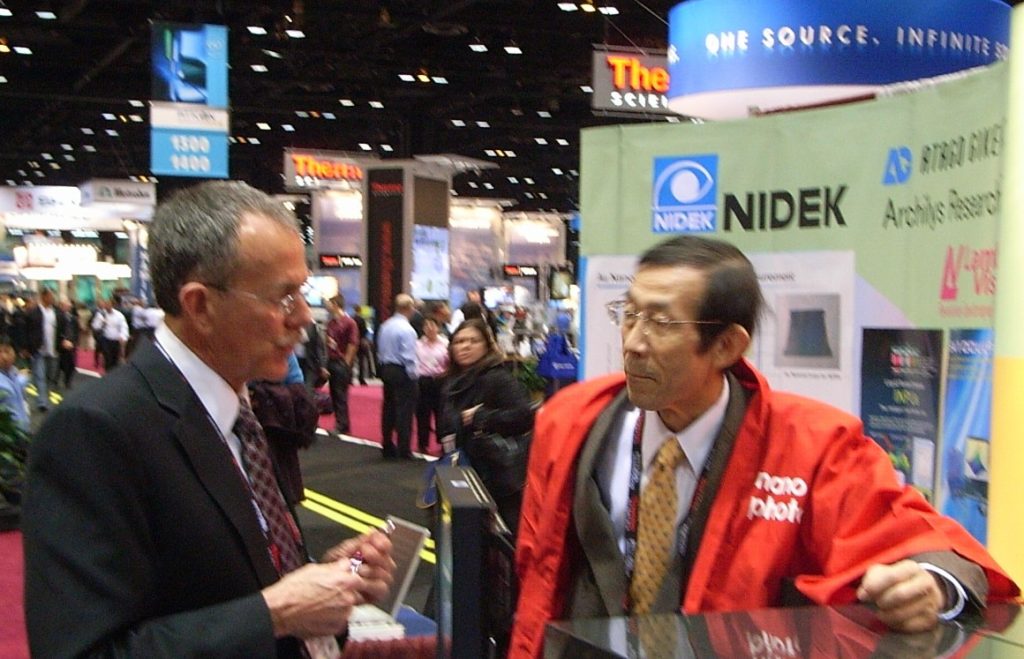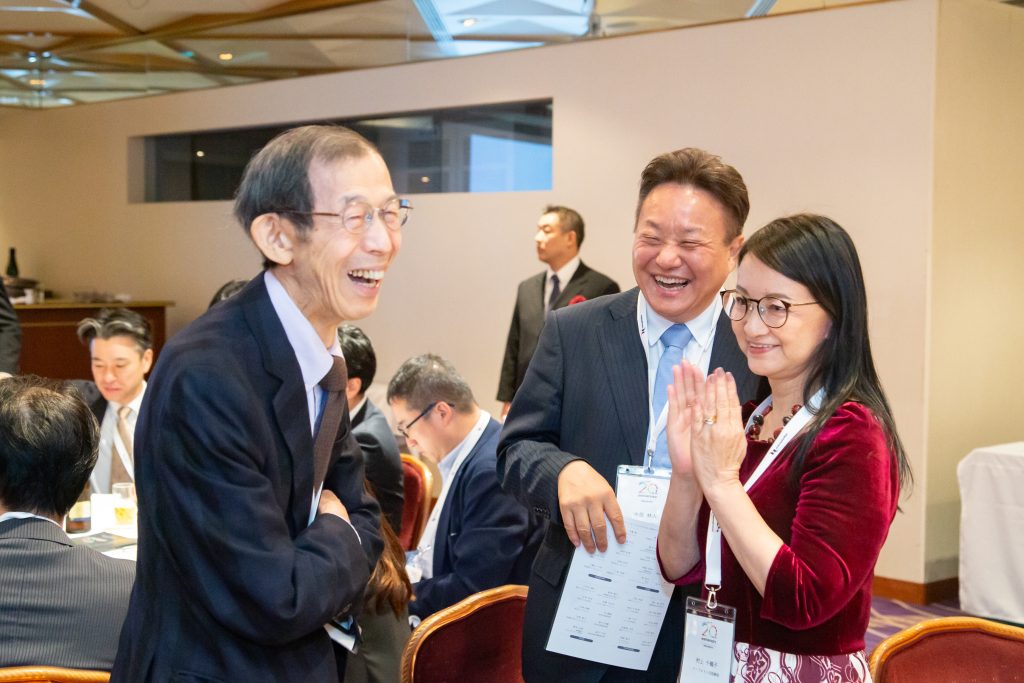Email Magazine
20th anniversary
This is the third in a series of interviews with past officers and directors to unravel the history of Nanophoton as part of our 20th anniversary commemorative efforts. We interviewed Mr. Shinji Wakamatsu, who served as Nanophoton’s director at the time and laid the foundation of Nanophoton as a company. (Newsletter editor: Ryo Harada)
Mr. Shinji Wakamatsu (former representative in the U.S. for Hakuto Corporation)

ーPlease tell us how you became involved with Nanophoton at that time.
Wakamatsu – – Around the fall of 2006, I was living in the U.S. at the time as a representative and director of Hakuto, a trading company specializing in imports, and I attended Dr. Kawata’s lecture at the Crowne Plaza Hotel in Silicon Valley, California, and talked to him about various topics afterward. The following January, I met him again at Photonics West (the largest optical-related trade show) in San Jose, and introduced him to an acquaintance of mine at a company that might be interested in marketing Nanophoton’s optical components. That is how I came to associate with Dr. Kawata.
Wakamatsu – – Later, I was to leave the company and return to Japan in March, and Dr. Kawata asked me if I would be interested in helping him. I was asked if I could help. I thought it would be interesting, as I wanted to try exporting as well as importing, and I agreed to help. In a sense, I was picked up by the company.
Hakuto was originally a company that imported and sold rough quartz crystals from Brazil. Mr. Shigeo Takayama was born in the U.S., came back to Japan, graduated from Nagoya Higher Commercial School (now the Faculty of Economics of Nagoya University), and later worked for ITOCHU Corporation before starting his own business. I joined there in 1973 and initially worked in the semiconductor business.
ー What did you do at Nanophoton?

Wakamatsu – – As director in charge of sales, I was free to work as I pleased. When I arrived, there was still no sales representative and no system in place. The first Laser Raman microscope sold well in Japan, and we decided to expand overseas, so we did various things.
The first memorable overseas production was in India. The University of Madras, which has a department founded by a disciple of Chandrasekhar Raman, the first Asian to win the Nobel Prize in Physics, was the delivery destination. The professor there liked it and bought it. Later, a teacher at a university in Beijing, China, bought it. We also took demo units to Korea, Singapore, and later to Germany.
In 2009, we had a booth at Pittcon (the largest exhibition for analytical instruments) in Chicago, USA.
ーDid the sale of the first unit in India create momentum for overseas expansion?
Wakamatsu – – It was very exciting (although I was probably the most excited). Prof. Berburgan, the dean of the University of Madras and head of the campus, came to Nagoya University from time to time, and he liked it so much that he bought it. However, it was hard work. The power often goes out, so we had to install a power supply to restore power, but the one we brought from Japan did not work well, so we ended up having to buy one in India. Mr. Ota had to make several trips to the area.
After Mr. Nakahara became the second president of Nanophoton, he did the expansion into China. We went to Xiamen University, which is said to be an authority on Raman, and we were able to talk quite well with a professor there who selected us and bought our product.
One unit was sold in India, two in China, one in Korea, one in Singapore, and one in Germany.
We also brought a demo unit to the United States. Northwestern University in Evanston, Illinois, a suburb of Chicago. This is the town where the Rotary Club is based and is quite a famous university in the Midwest. Then we moved it to Illinois State University.
ーI bet there was a lot you didn’t know about sales, wasn’t there?
Wakamatsu – – Yes, it was. However, even though I didn’t know what I was doing, it wasn’t a question of knowing or not knowing how to sell something; if I knew the equipment, I could handle most things. Also, I think I was able to make use of my previous experience at Hakuto. Specifically, it was negotiating with various people. I did a variety of things, including negotiations and contracts overseas, which was very useful. Because I had such a foundation, I thought I would try sales. If I was going to do it, I wanted to sell good products overseas and expand globally.
In addition, because there were limits to what we could do on our own, we had not previously entered into distributorship agreements, but we focused on how to develop distributorships. There is a Nikon sales company called Nikon Instec (now Nikon Solutions Inc.), and Nanophoton had been using their microscopes to make laser Raman microscopes. We also approached a number of other distributors and were able to increase the number of distributors.
There are not so many options as to how to make people aware of the product, and it is not possible to sell just because you spend money on advertising. Since the target market is usually well-defined, we have no choice but to show that the application of laser Raman microscopes and their applications have advantages and are useful for research in those areas so that they can use them. In this sense, distributors are also important. If they are dealing with scientific instruments or analytical instruments, they know the market because they go to places where Raman microscopes are used. The same is true overseas. How to use distributors was also important in China and Korea. As a small company, there is not much we can do where we don’t have a hand, so I think agents were a good option.
ーI understand that Mr. Wakamatsu’s contribution to sales, such as the introduction of the agency system, was significant.
Wakamatsu – – The first Raman microscope sold after I joined the company, and after that it started selling, so in that sense I feel that I made a small contribution to sales. After that, we did quite a bit of domestic sales. Hyogo was the first, and after that we sold to various places, including the Industrial Technology Center of Okayama Prefecture, the Sumika Analysis Center, and the National Institute of Advanced Industrial Science and Technology (AIST).
ーWhat was the period during which you were with Nanophoton over the past 20 years?
Wakamatsu – – I think it was a time when the company was heading toward stability. Until then, we did not have a full-time sales person, so we set up that structure and were able to stabilize domestic sales and sell overseas as well. Mr. Ode, the first president of the company, always said that a company is not a company unless it makes a profit, and that it can contribute to society only when it makes a profit. It is important to make a profit, have the company function properly, and pay taxes. Otherwise, it is not a company. After that, Mr. Nakahara became the second president, and he laid the foundation for the company that would lead to the next stage. Specifically, he was responsible for solidifying the company’s organization. I think he thought a lot about what kind of organization he wanted to create and all the other aspects of the company.
ーWhat kind of company was Nanophoton at that time?
Wakamatsu – – When I was working as a sales representative at Nanophoton, I realized that it was easy to work with smart people. Everyone around me was really smart, including the people who joined Nanophoton later on, so it was really easy. It was easy to convey intentions and to talk quickly. I was able to work quickly, listen to the customer’s requests, and have them respond accordingly.
On the contrary, I believe that you basically have to be an idiot to work in sales. Smart people in the world think that doing this is not worth it, and they complete everything in their minds. However, for us, what we did even though we thought it was a waste of time sometimes led to an order. In fact, that’s what happened when Sony Corporation bought. I knew someone at Sony, so I asked, “How would you like our product to Sony?” Then they said, “We don’t need it because it has nothing to do with us.” But can I go and sell the product anyway?” I asked them, and we got to talking, and eventually they decided to install it.
I thought that there is no such thing as waste in human behavior. Even if it looks like waste, it can lead to something. I really felt that it is important to visit a place without thinking it is a waste of time. That’s why I love NIKE’s advertising. “Just Do It.” I love this. The atmosphere of “just do it” is important. I tell people to take action first, rather than thinking about what to do next. I say this to them whenever I have a chance.
ーThank you very much, Shinji Wakamatsu.
I am very happy to hear that. Nanophoton will continue to take on the challenge of the next stage as Nanophoton 2.0, with Mr. Wakamatsu’s thoughts firmly in mind.

(Translated by DeepL)